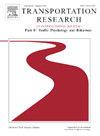The Predictive Role of visual attention bias in aggressive driving decisions among violation-involved drivers on attitudes of right-of-way
IF 3.5
2区 工程技术
Q1 PSYCHOLOGY, APPLIED
Transportation Research Part F-Traffic Psychology and Behaviour
Pub Date : 2024-10-04
DOI:10.1016/j.trf.2024.09.024
引用次数: 0
Abstract
This study, based on dual-process theory, explores the aggressive driving decision-making characteristics and cognitive processing of violation-involved drivers in right-of-way infringement scenarios. It aims to identify an eye-movement indicator that can predict drivers’ prosocial behaviors. The study recruited 75 drivers aged 19–58 years, who completed a video-based aggressive driving decision-making test and the Driver Attitudes of Right-of-way Questionnaire (DARQ). The results indicate that age moderates the relationship between violation history and visual attentional bias. Younger drivers with a history of violations exhibit an attentional bias towards aggressive words, whereas older drivers do not. After controlling for age, violation-involved drivers demonstrated a higher rate of aggressive decision-making, especially in situations with very short lane-change time headway. Visual attentional bias towards aggressive words can effectively predict positive emotions in attitudes towards the right-of-way. This suggests that early eye movement indicators during the driving decision-making process represent a form of socioemotional characteristic. The more positive the driver’s right-of-way attitude, the stronger their prosocial behavior and the weaker their intuitive impulsiveness during the early cognitive processing stages of driving decision-making. This indicates that the driving decision-making eye-movement assessment paradigm is an objective and effective method for evaluating drivers’ pro-sociality.
视觉注意力偏差在违规驾驶者做出攻击性驾驶决策时对路权态度的预测作用
本研究以双过程理论为基础,探讨了在侵犯路权情景下,违规驾驶者的攻击性驾驶决策特征和认知过程。其目的是找出一种能预测驾驶员亲社会行为的眼动指标。研究招募了 75 名年龄在 19-58 岁之间的驾驶员,他们完成了基于视频的侵犯性驾驶决策测试和驾驶员路权态度问卷(DARQ)。结果表明,年龄调节了违章史与视觉注意偏差之间的关系。有违章记录的年轻驾驶员会表现出对攻击性词语的注意偏向,而年龄较大的驾驶员则不会。在控制了年龄因素后,有违章记录的驾驶员做出攻击性决策的比例更高,尤其是在变道时间很短的情况下。对攻击性词语的视觉注意偏差可以有效预测对路权态度的积极情绪。这表明,驾驶决策过程中的早期眼动指标代表了一种社会情感特征。在驾驶决策的早期认知处理阶段,驾驶员的右侧通行态度越积极,其亲社会行为就越强烈,直觉冲动性就越弱。这表明驾驶决策眼动评估范式是评价驾驶员亲社会性的一种客观有效的方法。
本文章由计算机程序翻译,如有差异,请以英文原文为准。
求助全文
约1分钟内获得全文
求助全文
来源期刊
CiteScore
7.60
自引率
14.60%
发文量
239
审稿时长
71 days
期刊介绍:
Transportation Research Part F: Traffic Psychology and Behaviour focuses on the behavioural and psychological aspects of traffic and transport. The aim of the journal is to enhance theory development, improve the quality of empirical studies and to stimulate the application of research findings in practice. TRF provides a focus and a means of communication for the considerable amount of research activities that are now being carried out in this field. The journal provides a forum for transportation researchers, psychologists, ergonomists, engineers and policy-makers with an interest in traffic and transport psychology.

 求助内容:
求助内容: 应助结果提醒方式:
应助结果提醒方式:


